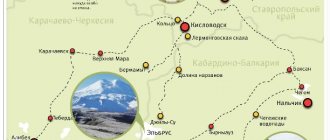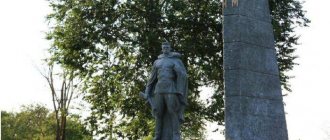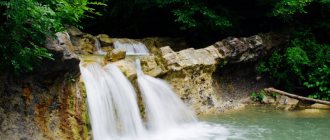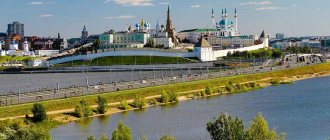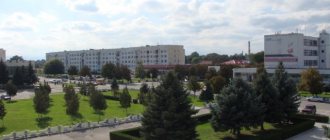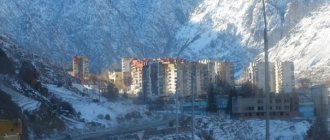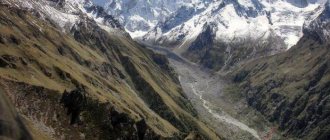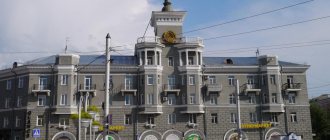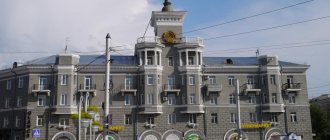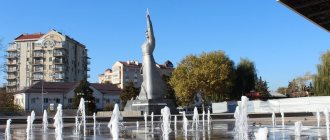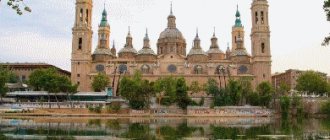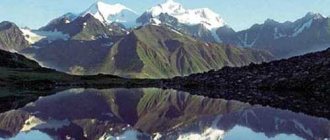Where is the city?
The length of the territory of the Kabardino-Balkaria in the direction from south to north is 100 km, from east to west - 175 km. The republic borders on the east/southeast with Ossetia-Alania, and on the south it neighbors Borjomi and Georgia.
The urban district of Nalchik is located at an altitude of 512 m above sea level, geographical latitude 43 ° and longitude 36'.
From a geomorphological point of view, the territory of the capital is equated to an area that passes from low foothills to a slightly sloping plain.
Administrative division
Kabardino-Balkaria appeared on the map of Russia in 1921 as an autonomous region, becoming a republic only in 1992. The capital of the republic is the resort city of Nalchik.
According to the administrative and legal structure, it is divided into 3 urban districts and 10 districts with rural settlements and towns:
| Municipality | Name | Settlements of the municipality |
| Urban district | Nalchik | 1) City of Nalchik; 2) 8 villages. |
| Baksan | 1) Baksan city; 2) the village of Dugulubgey. | |
| Chill | Prokhladny city | |
| Area | Elbrus | 1) the city of Tyrnyauz; 2) 6 settlements. |
| May | 1) City of May; 2) 4 settlements. | |
| Tersky | 1) Terek city; 2) 17 settlements. | |
| Prokhladnensky | 1) Prokhladny city; 2) 19 settlements. | |
| Chereksky | 1) Kashkhatau town; 2) 9 settlements. | |
| Baksansky | 1) Baksan city; 2) 13 settlements. | |
| Urvansky | 1) The city of Nartkala; 2) 11 settlements. | |
| Zolsky | 1) Urban settlement Zalukokoazhe; 2) 15 settlements. | |
| Chegemsky | 1) City of Chegem; 2) 9 settlements. | |
| Leskensky | 9 settlements. |
Climate and weather
Kabardino-Balkaria, like all North Caucasian republics, is located in the temperate climate zone. An important factor influencing the formation of the weather, as well as a unique climate divide, are the mountain peaks of the Greater Caucasus, which fence off and protect the city from cold winds from the south and southwest.
A significant role in climate indicators is played by the terrain, which influences the distribution of precipitation, activating and increasing the volume of precipitation during the entry of air masses into the territory of the republic.
The table shows average climatic indicators:
| Temperature parameters | |
| In January | -4 °C on the plains and 12 °C in the mountains |
| In July | +23… +4 ° respectively |
| Duration of sunshine - 1810 hours per year | |
| Winter | 203 h |
| Spring | 443 h |
| Summer | 667 h |
| Autumn | 449 h |
| Humidity - 78% | |
| Winter period | 85–86% |
| In summer | 68–69% |
Winter in the republic begins in late November or early December and is characterized as moderately mild with an average temperature of approximately -3... -4 °C. At this time, thaws and moderate frosts often occur. The height of the snow cover does not exceed 10 cm.
The hottest months are observed in July–August – temperatures sometimes reach 38 °C. Particularly heavy precipitation occurs at the end of spring and summer, when there are rapidly passing thunderstorm showers.
Such rains perfectly purify the air and have a powerful ozonizing effect that is beneficial for nature and human health. The most comfortable months to visit Nalchik are May, June and September.
Founding history
Scientists associate the origin of the city’s name with the word “nal”, which means “horseshoe” translated from the Kabardian and Balkar languages. And indeed, if you look at the location of the settlement from a bird's eye view, the city, surrounded in a semicircle of mountain peaks, very much resembles the shape of a horseshoe.
Nalchik is divided into small areas with the following popular names:
- Mountain.
- Center.
- Arrow.
- Calm.
- Distortion
- Volny Aul.
- Oak trees.
- Alexandrovka.
- Resort "Dolinsk".
In 2005, new territorial divisions appeared - Kenzhe, Khasanya and Adiyukh.
Travel around the administrative center is provided by three types of transport:
- trolleybuses;
- by bus;
- public and minibus taxis;
- by rail.
Nalchik (the city is located in the south of Russia), according to various sources, was built as an outpost by General Ermolov in 1724–1943. Gradually, the erected fortress acquired economic and residential buildings, in which by 1971 about 3 thousand people lived.
The small settlement was actively growing and by 1921, when the settlement received city status, it had approximately 5 thousand inhabitants.
In 1941–1943 Soviet troops carried out the Nalchik-Ordzhonikidze military operation, as a result of which a significant part of the city practically ceased to exist, so great was the destruction.
However, the capital of the Kabardino-Balkarian Republic was restored by the efforts of its inhabitants - true patriots who sincerely love their homeland, the blessed land on which their ancestors lived and their descendants were born.
A terrible tragedy that affected the indigenous people of the republic occurred in 1944, when, by order of the USSR State Defense Committee, 37,713 Balkars were forcibly evicted to the regions of Kyrgyzstan and Kazakhstan for their alleged participation in collaborationist formations. The repressions carried out led to the death of a large number of innocent people.
This action was subsequently recognized as genocide of the people, people were completely rehabilitated with the restoration of all civil rights.
Residents of the capital of the Kabardino-Balkarian Republic sacredly honor and cherish their historical/cultural values and traditions; scientists are constantly working on the revival and preservation of the national epic.
Population
The population of Nalchik reaches 240,131 people, which puts the capital of the Kabardino-Balkaria in this indicator at 79th place among 1,117 cities in Russia and 1,497th place in the world ranking. In terms of national composition, the top three are Kabardians (49.25%), followed by Russians (28.77%) and Balkars (12.16%).
The rest of the group includes Ossetians, Chechens, Ukrainians, Georgians and Armenians. Despite such diversity, the residents of the city and the republic are distinguished by great tolerance, respect for their own and others’ customs and traditions, and a friendly and hospitable attitude towards city guests.
What to bring as souvenirs
As a gift from Kabardino-Balkaria, both a bottle of healing water from mineral springs, which has a limited shelf life, and souvenir attributes symbolizing the Caucasus are suitable:
- Magnets, mugs, T-shirts, figurines with landscapes of mountains and lakes.
- Items made of natural sheep wool with traditional deer patterns.
- Wool carpets.
- Attributes of the life of the mountaineers - hats, daggers, horn cups.
- Details and decorations of national clothing created by the hands of local artisans.
- Wall horns of artiodactyl wild animals.
- Dishes made of black clay.
- A doll in national dress.
- Paintings by local artists with landscapes of Kabardino-Balkaria.
- Interior decorations made of felt, reeds and leather.
- Local cognac in crystal horns and daggers, which can only be bought at the market (officially discontinued).
It is not for nothing that Kabardino-Balkaria is considered the pearl of Russia. Despite such a small size on the map, in comparison with other regions, the republic is distinguished by its amazing natural beauty, variety of attractions and types of tourism.
The abundance of healing mineral springs located in ecologically clean areas makes it one of the most popular resort areas in the country.
Author: Anna Lalochkina
Article design: Vladimir the Great
Tourism
The unique natural resources of Kabardino-Balkaria, clean and harmless air, as well as a whole complex of medical and educational facilities located on the territory of the city and the republic, places for sports and active recreation annually attract the attention of thousands of travelers from all regions of Russia, near and far abroad.
The main and most popular types of tourism include the following areas:
- environmental - 2%;
- active tourism - 45%;
- recreational and therapeutic - 23%;
- cultural and educational - 27%;
- extreme and adventure - 5%.
The most popular and priority is considered to be sports recreation, which includes the following types of entertainment:
- mountaineering;
- walking, horseback riding and cycling tourism;
- paragliding;
- skiing.
Medical and health tourism in Nalchik is provided with climatic and balneological resources that allow achieving positive dynamics in the treatment of various diseases. The same goals are facilitated by a mild climate, clean and fresh air. The sanatorium-resort zone is allocated the best territory in the city called “Dolinsk” in the area of the national park.
Sanatorium "Dolinsk"
Every year hundreds of thousands of tourists come to Nalchik, for whom about 40 sanatoriums have been built, equipped with modern medical equipment with the assistance of experienced medical specialists.
Most health resorts actively use the beneficial properties of the mud of Lake Tambukan and healing waters from mineral springs in treatment. In addition to recreational activities, the administration of the institutions organizes tourist trips to the best places in Kabardino-Balkaria.
In addition to sanatoriums, there are many hotels and recreation centers with comfortable rooms and modern technical equipment in Nalchik. It is possible to choose an excursion program to the most picturesque places of the republic on your own, but it is better to use the professional services of specialized bureaus and travel agencies.
Company employees will offer guests group or individual itineraries, taking into account financial capabilities, personal wishes and target preferences.
Holidays in the region
Kabardino-Balkaria occupies a fairly small area on the map, but at the same time it is one of the most favorable regions of Russia for recreation and tourism.
In the foothills of Balkaria there are cold and hot mineral springs. Thanks to the healing properties of water and mud, many tourists come here every year. The resort business is well developed in the republic, and all kinds of boarding houses and health centers are ready to offer their services.
The region is a leading center for skiing and mountaineering. The number of people wishing to conquer the heights of Elbrus and other five-thousand-meter mountains (with peaks above 5 thousand meters above sea level) is constantly growing. Kabardino-Balkaria offers sports recreation for both professionals and amateurs.
The most popular routes are the Elbrus and Cheget mountains, which are part of the Elbrus region. The ski slopes on Cheget are some of the most difficult to navigate, and avalanches occur quite often.
For the convenience of vacationers, there are cable cars and ski lifts with breathtaking views of wildlife. You can get the necessary sports equipment and equipment, as well as use the services of an instructor, at one of the many tourist centers.
Downhill trails are leveled and rolled using special equipment, and for extreme sports enthusiasts there are undeveloped slopes. It is here that one of the most spectacular annual events of the republic is held - freeride competitions.
In addition to sports recreation, excursion tours to mountain gorges, protected forests, waterfalls and lakes are popular among tourists. Mountain caves are also interesting, many of which have not yet been explored. In some of them you can find underground lakes, stalactites and traces of ancient people.
In the foothills of Kabardino-Balkaria, winters are milder than in the flat areas, and summers are moderately comfortable. Snow and glaciers on the mountain tops do not melt even in summer, while in the steppes it is hot and dry.
The summer ski season lasts until about mid-July, and sometimes longer. Therefore, tourists can be found here at any time of the year. Although a summer vacation will cost an order of magnitude cheaper than the winter tourist season.
Natural attractions
Nalchik (the city is located 114 km from Mount Elbrus) and Kabardino-Balkaria as a whole are of undoubted interest for guests of the republic. Every tourist will not only be able to diversify their vacation by visiting the capital’s cultural and entertainment sites, but also get real pleasure from exploring unique natural and sports attractions and ancient architectural monuments.
Elbrus region
To enjoy crystal clear air, admire stunning views of mountain landscapes, and go down steep slopes on skis or paragliders, you don’t have to go to Switzerland or the Alps.
All opportunities for active and walking recreation will be provided by the Elbrus National Natural Park with its unique nature, rare plants, the fabulous beauty of stormy mountain rivers and mesmerizing waterfalls gushing from underground mineral springs.
The central object and place of unique tourist attractions is the majestic double-headed Elbrus - a stratovolcano, the highest point in Russia and Europe (5,642 m above sea level). The hill, the formation of which began 2–3 million years ago in the Upper Pliocene, is located 10 km north of the Main Caucasus Range.
Elbrus has always attracted people with its mystery and magical power. It is no coincidence that the mountain is mentioned in art and legends, sung in the poems of M. Lermontov and V. Vysotsky, described in the prose of I. Bunin and N. Nekrasov.
It was here that the fascist Nazis from the Anneerbe community rushed in search of the “entrance to Shambola” in order to master the mystical secret of conquering the world. Today, at an altitude of 3,500 m, the highest mountain military museum on the planet, “Defense of the Elbrus Region,” is located.
The two-headed giant became not only the personification of natural splendor, but also the center of such sports entertainment:
- Every year more than 10 thousand tourists of all ages climb the snowy peaks;
- the eastern and northern slopes attract skiers, as well as fans of extreme sports - heli skiing, snowboarders and freeriders;
- the mountains neighboring Elbrus, covered with forests, alpine meadows, rare herbs and flowers, are of particular interest to lovers of paragliding, rock and ice climbing, trekking, mountain biking and heli-skiing;
- The chairlifts installed on the mountain giant will allow you not only to rise to the desired height, but also to simply immerse yourself in the charm of snow-capped mountain peaks, as if connecting heaven with earth.
At the foot of Elbrus there is a village. Terskol, the main purpose of which is to create all the conditions necessary for a comfortable stay for skiers, tourists and travelers. Comfortable hotels, boarding houses, chalets and mini-hotels for a pleasant stay have been built here, baths and saunas, cafes and restaurants, and ski equipment rental places are open.
Blue Lakes
Nalchik is a city in which there are several swimming pools with clean filtered water for recreation of residents and guests of the republic.
However, the Blue Lakes, located 60 km from the capital of the republic in the mountains of the Cherek Gorge, are of undoubted interest. It is there, among the rocks and virgin forests, that unique natural monuments are located - stunningly beautiful karst reservoirs, a visit to which is certainly included in excursion programs.
The Lower Blue Lake “Chirik-kel” (translated from the Balkar language means “rotten lake”) is a natural artesian well 258 m deep with a constant water temperature (9.3 °C) that does not freeze in winter. Not a single stream flows into this reservoir, but up to 70 million water flows out of it per day.
The legendary traveler Jacques Cousteau tried to reveal this secret, but the researcher did not obtain reliable information on this mysterious phenomenon.
There are two more Upper Blue Lakes (Eastern and smaller Western) - Dry, similar to a large pit, and Secret - densely surrounded by dense forest, attracting with its special mystery.
Scientists associate the formation of these reservoirs with processes occurring in the voids of the earth’s crust. All three lakes amaze with the unusual beauty of the water, the hue of which changes depending on the weather, time of year, and the angle of the sun's rays falling into the depths of the reservoir.
Chegem waterfalls
The presented natural attractions are located 55 km from Nalchik in the Chegem Gorge near the village of the same name.
Each of these objects has its own name and the following characteristics:
- The large Chegem waterfalls appear before the eyes of travelers in the gorge of the same name, the width of which sometimes narrows to 25 m. The waterfall on the river is the first to greet amazed tourists. Sakal-Tup. The configuration of the place through which the water streams flow looks like a stone gutter, but the volume of water passing through it is noticeably smaller than that of its “brothers”.
- The “Crying” or Main Chegem Waterfall makes the greatest impression. A mass of water collected from small streams falls from a 60-meter height in three cascades, making their way among the rocky crevices.
- Ady-Su (Maiden's Spit) is more like a huge 30-meter trench made of stone, along which tons of water quickly flow.
Falling water streams sparkle and shimmer in the rays of the sun, so here you can often see a spectacular spectacle - the delicate outlines of a colorful rainbow.
Watchtowers
These buildings, representing the cultural heritage of Kabardino-Balkaria, are located in Upper Balkaria next to the ruins of ancient villages. Scientists believe that the core of ethnic Balkars was formed in these places. The most famous settlement site studied by archaeologists is considered to be Kyunnyum-El.
Of the 9 surviving terraces supported by retaining walls, the watchtower of the Abaev princes is in the best condition. Solid and strong structures were erected next to outbuildings and hut houses, so that in case of danger the family could take refuge in a powerful fortress. The thickness of the walls, slightly inclined inward, was about 2 m, and the height was 17 m.
The archaeological and tourist complex in the southeast of the Cherek region includes not only watchtowers, but also crypts, feudal residences, underground and above-ground mausoleums, which arouse genuine interest among travelers.
Valley of Narzans
Nalchik (the city is located just 120 km from the popular tourist site under the romantic name “Valley of Narzanov”) has its own drinking gallery with the ability to receive natural mineral water from thermal springs (Shogentsukova St.).
If you want to try such a healing drink that comes directly from the earth, tourists can go to the mouth of the Khasaut River, where the Main, so-called boiling cauldron, from which natural narzan flows, is located at an altitude of 1,300 m above sea level. 100 m from it there is a lower mineral spring with healing moisture.
The length of the Narzanov Glade is about 3 km, along which 20 natural springs flow from the ground. The nature around them, with its incredible colors, resembles the Martian landscape.
Aushiger thermal springs
A unique natural object, the healing power of which is known far beyond the borders of Kabardino-Balkaria, gives people beauty and health. The attraction is located just 20 km from Nalchik.
The history of the discovery of healing waters dates back to 1950, when geologists, instead of oil, found the Aushiger hot springs, unique in their chemical composition, the water from which can not only be used for bathing, but also drunk as a healing agent. It is recommended to arrange health procedures for medical reasons after consultation with your doctor.
Historical reference
On the territory of the Kabardino-Balkarian Republic, human activity can be traced back to ancient times - from the primitive communal system. In the Baksan Gorge, sites of primitive people of the Late Paleolithic were discovered. The best preserved graves and settlements of the 2nd-1st millennium BC near Nalchik are the Agubekovskoye settlement and the Dolinskoye settlement.
By the end of the 1st century. BC. In the steppes, on the lands of the inhabitants of the North-Western Caucasus, Alans penetrate, who formed a vast Alan union. They dominated the North Caucasus for more than 1000 years and left behind numerous historical monuments. The center of the Alanian state was the territory of the Kabardino-Balkarian Republic and North Ossetia. It is here that grandiose earthen Alan fortifications - fortifications - are found in large numbers, each of which occupies an area of 10-15 hectares, as on the hill between the Baksan and Chegem valleys. They are found near the villages of Argudan, old Lesken, Upper Akbash, Zhemtala, Psygansu and Elkhotovo. In the first quarter of the 13th century, a devastating invasion of the North Caucasus by the Mongol-Tatars began. The spearhead of the Mongol aggression in the central part of the Ciscaucasia was directed against the Alans, who were defeated in the 13th-14th centuries and ceased to exist independently, taking refuge in the mountains and mixing with mountain tribes to form the Ossetian, Balkar and Karachay peoples. Along with agriculture and cattle breeding, they were engaged in wool processing and making felt carpets-kiizs, leather dressing and weaving, and blacksmithing.
Two neighboring peoples - Kabardians and Balkars - constantly maintained close friendly ties, conducted lively trade and exchanges between themselves and their Caucasian and Russian neighbors, and fought together against common enemies. Even in the first half of the 13th century, the invaders found almost all the gorges of the Central Caucasus fortified. The appearance of rock fortifications, watchtowers in mountain villages and entire fortresses dates back to this time. The Amirkhan Tower in the Cherek Gorge, the Ak-Kala Tower and others date back to this time. In the 14th century, entire fortified citadels appeared, for example Uskhurskaya, which was associated with a new wave of invasions - the campaigns of Timur. Moving from west to east, the ancestors of the Kabardians, who came from the Azov and Kuban regions in search of pastures and fertile lands, first occupied Pyatigorye, and then the territory of modern Kabardino-Balkaria. Since then, the flat part of what is now Kabardino-Balkaria began to be called Kabarda.
Fragmented and weakened by constant struggle, Kabarda had difficulty defending itself from new enemies. It was then that Prince Temryuk Idarov decided to send ambassadors to Moscow, who voiced a request to accept the Kabardians as Russian citizens and protect them from external danger. Thus, a military-political alliance was concluded between Kabarda and Russia. Since that time, friendly ties between peoples have expanded, economic, political and cultural rapprochement begins. In an effort to strengthen these ties, Ivan the Terrible in 1561 married Temryuk’s daughter, Kuchenya, who was named Maria after baptism.
Throughout the 16th-18th centuries, the peoples of the North Caucasus, together with the Russians, participated in the struggle against common enemies - Turkey and Crimea, and in the north - against the Livonian Order, Poland and Sweden. In 1707, the Crimean Tatars with a large army invaded Kabarda, but the Khan’s army was driven back to the Kuban. This event led to the issue of Kabarda being considered at the Belgrade Peace Conference. According to Article 6 of the Belgrade Peace Treaty, signed in 1739, Kabarda was proclaimed “free”. Both empires (Russia and Turkey) pledged not to interfere in the internal affairs of the “Pyatigorsk Circassians” - Kabardians. In 1714-1722, Peter I sent regular troops to the Terek for the constant protection of Kabarda.
At the same time, direct connections between the Russians and Balkaria were established, through which one of the embassy routes to Western Georgia ran. The self-name of the Balkars is “taulu” - mountaineers, but there are more private names based on the names of mountain gorges and, accordingly, societies: malkarlyla, byzyngylila, holamlyla, chegemlslyla. The basis of the Balkar economy has traditionally been animal husbandry with a predominance of small cattle. In 1787, the elders of Balkaria turned to Count Potemkin with a request for citizenship. The date of the final annexation of Balkaria to Russia is considered to be January 11, 1827, when a Balkar-Digor deputation arrived in Stavropol - one representative from each princely family. This delegation asked to accept them as Russian citizens. The victory of Russia in the Russian-Turkish war of 1768 - 1774 finally decided the fate of Kabarda, when Turkey, according to the Kuchukkainardzhi Peace Treaty, recognized it as part of Russia. Since then, Russia's position in the North Caucasus has been strengthening. At a fairly short distance from each other, guard fortresses with a regular military garrison began to be built, which by the first half of the 19th century made up the so-called Caucasian Line. The first Russian settlers in the North Caucasus were peasants who fled here from their landowners and founded the Terek Cossack freemen here in the 16th century. In Kabarda, royal fortresses and fortifications were built - Ekaterinogradskaya, Prokhladnaya, Kamennomostskaya, Nalchikskaya, Baksanskaya and others.
Ermolov appointed the Nalchik fortress, which had a direct connection with Vladikavkaz, as the main point at which the entire military-administrative management of Kabarda was to be concentrated. Nalchik at that time was a fortress surrounded by wooden walls, an earthen rampart and a deep moat. It housed the command of the Center of the Caucasian Line, the leadership of the fortress and the temporary Kabardian court. Nearby were the garrison barracks, a wooden church and a dozen turkish houses. Below the fortress, along the banks of the Nalchik River, there was a forstadt (the outskirts of the fortress). Behind the fortress walls stood a dense forest. The way of life and way of life of the Kabardians were almost no different from the life of other Adyghe peoples and were also regulated by customary law and the Sharia court. But, speaking about pre-revolutionary Kabarda, one cannot fail to mention the traditional practice of horse breeding. A beautiful riding horse was bred here, called Kabardian and supplied to the cavalry units of the Russian army. It should also be noted that the availability of good pastures and their rational use led to a high level of development of livestock farming.
In 1867, serfdom was abolished in Kabarda and Balkaria. In the second half of the 19th century, Kabarda was an underdeveloped agricultural province, with emerging prospects in the field of mountain travel. Back in 1829, the first Russian expedition set off to Elbrus. It included the geologist and geographer Kunfer, the physicist academician Lenz, the botanist Meyer, and the architect of Pyatigorsk Bernardazzi. The expedition was accompanied by the head of the Caucasian line, General Emmanuel, with a detachment of 1000 Cossacks. But only the expedition guide, Kabardian Killar Kashirgov, reached the summit. The expedition left two inscriptions on the top, indicating the priority of the Russians in the conquest of Elbrus. It is also worth noting another famous conqueror of the highest peak in Europe - the Balkar Akhiya Sottaev repeatedly climbed its peaks. A great contribution to the compilation of maps of the Caucasus was made by the famous Russian cartographer and researcher of the Caucasus A.V. Pastukhov.
In 1913, a railway was stretched through the territory of the republic, a branch was built to Nalchik, a railway station building and outbuildings were built, which have been preserved and are functioning to this day. After the revolution of 1917, the process of autonomization began in the North Caucasus. In January 1921, the All-Russian Central Executive Committee issued a Decree on the formation of the Mountain Autonomous Soviet Republic, which included Kabarda, Balkaria, Ossetia, Ingushetia and Chechnya. The Mountain Republic was destined to have a short life: in June of the same 1921, Kabarda left the Mountain Republic, declaring itself an autonomous region within the RSFSR. The Bolshevik Betal Kalmykov was elected head of the new Kabarda, and the city of Nalchik became the administrative center.
On September 1, 1921, the Kabardian Autonomous Region was formed as part of the RSFSR, and in January 1922, a single Kabardino-Balkarian Autonomous Region was formed, transformed in 1936 into the Kabardino-Balkarian Autonomous Soviet Socialist Republic.
The pre-war years were filled with hard work in all areas of the economy and culture. Industry was created: in the region, where at the turn of the century literacy barely reached two percent, a network of secondary schools and secondary specialized educational institutions was created.
During the Great Patriotic War, all residents of Kabardino-Balkaria made a worthy contribution to achieving the great victory. More than sixty thousand envoys of the republic bravely fought with enemies on all fronts of the war, in partisan detachments not only within the country, but also far beyond its borders. The Motherland highly appreciated the exploits of the soldiers from Kabardino-Balkaria. Twelve thousand of them were awarded state awards, thirty-three people became Heroes of the Soviet Union - six - full holders of the Order of Glory. For the courage and fortitude shown by the working people of the capital during the war, the city of Nalchik was awarded the Order of the Patriotic War, 1st degree. And yet, for the residents of the republic, the joy of victory was overshadowed by the repression of the Balkar people, who in 1944 were deported to Central Asia and Kazakhstan. This barbaric action was committed at the very time when his best sons shed their blood in the fight against the Nazi invaders. The Balkars spent 13 years in exile and returned to their homeland in 1957.
After the war, the republic recovered quite quickly - industry, agriculture, construction, as well as the tourism industry (mountain tourism and mountaineering) actively developed. A considerable number of various camp sites, recreation centers and alpine camps were erected, which acquired all-Union significance. Great attention was paid to sanatorium-resort treatment. The city of Nalchik has become one of the recreation centers in the Caucasus. On April 5, 1957, a decree of the Council of Ministers of the USSR was signed on the opening in Nalchik of one of the first multidisciplinary higher educational institutions in the North Caucasus - Kabardino-Balkarian State University. In 1957, in honor of the 400th anniversary of voluntary accession to Russia, the second Order of Lenin appeared on the banner of the republic. In 1971 and 1972 the republic was awarded the Orders of the October Revolution and Friendship of Peoples. Laureate of the State Prizes of the USSR and the RSFSR, People's Poet of Kabardino-Balkaria Kaisyn Kuliev and laureates of the State Prize of the RSFSR named after Gorky, People's Poet of Kabardino-Balkaria Alim Keshokov and Tanzilya Zumakulova are becoming widely known outside the republic. Representatives of more than one hundred nationalities live in Kabardino-Balkaria.
Since 1991, Kabardino-Balkaria has become a subject of the Russian Federation with its own statehood, the institution of the president, parliament and government. The first president of the KBR was Valery Muhammedovich Kokov. Kabardino-Balkaria is a land of extraordinary natural contrasts due to its topography; here you can find arid steppes, flowering valleys, lush subalpine meadows and high mountains covered with eternal snow with inaccessible cliffs, fabulous glaciers and noisy waterfalls.
The capital of the republic is the city of Nalchik - a large cultural, scientific and industrial center, a resort city of All-Russian significance.
The economy of Kabardino-Balkaria is basically an established diversified national economic complex that corresponds to the natural and climatic conditions of the republic. An important part of the economic potential of the republic is the recreational complex, created on the basis of the use of medicinal mineral springs and unique natural conditions. Thanks to very favorable natural and climatic conditions, the multi-profile resort “Nalchik” was formed, which has mineral springs (bromine-iodine, nitrogen-thermal, hydrogen sulfide, mineral waters), and the mud spring of Lake Tambukan. Sanatoriums operating at the Nalchik resort provide treatment for the musculoskeletal system, diseases of the nervous system, gastrointestinal tract, upper respiratory tract, etc.
Modern objects interesting to visit
Nalchik is a cozy, spacious city surrounded by greenery, the hallmark of which is Atazhukinsky Park, which occupies 173 hectares. Founded in 1847 as an orchard, it became the main recreation place for residents and guests of the city. Named in honor of its founder, the Kabardian prince Atazhukin, the park represents the well-deserved pride of the republic.
The park has luxurious flower beds, which are the constant concern of talented florists, a variety of attractions have been built for children and adults, and cafes with national and European cuisine have been opened.
Restaurant "Bochka"
One of the paths of Atazhukinsky Park will certainly lead to a unique structure - a huge barrel, inside of which there is a 2-story beer restaurant.
It is impossible to deny yourself the pleasure of taking a selfie in front of this truly unique structure, then going to an amazing gastronomic establishment to quench your thirst with a glass of fresh foamy drink and taste the taste of national dishes.
Restaurant "Sosruko"
This is a monumental object, without visiting which no acquaintance with Nalchik is complete. The architectural complex, erected on Mount Malaya Kizilovka, is a structure made in the form of the head and outstretched hand with a torch of an ethnic hero - the hero Sosruko.
The observation deck located in front of the restaurant offers a magnificent panoramic view of the area from a height of 600 m. The spectacle is literally mesmerizing.
Museums of Nalchik
Nalchik (the city is located in a region that is quickly gaining ratings in terms of tourist attendance) is of undoubted interest in terms of its historical development. You can get acquainted with the culture, way of life, traditions and customs of the peoples inhabiting the republic by visiting museums of republican significance.
The most popular facilities include the following institutions:
- State United Museum of the KBR (Gorky St., 62).
- House-Museum of Marko Vovchok (Dolinsk).
- Memorial Museum-Apartment of A. A. Shogentsukov (Gorky St., 35);
- Panorama Gallery (Shortanova St., 40).
- Art Center Madina Saralp (Lermontov St., 2-a).
- Police Museum (Moskovskaya St., 10, building 2).
Art Center Madina Saralp, Nalchik
The “Upside Down House” Museum, the Einstein Museum of Entertaining Sciences, and the Memorial to Victims and Repressions of 1944–1957 are of undisguised interest to tourists and travelers. (Kanukoeva St.).
Theaters of Nalchik
The cultural life of the city is represented by three theaters:
- Kabardinsky Drama Theater named after A. Shogentsukov on the street of the same name.
- Republican Puppet Theater on the street. Kulieva.
- State Musical Theater on the street. 400th Anniversary Square, in which the Russian Drama Theater is located. M, Gorky.
- Green open air theater in Atazhukinsky Park.
- Variety Theater on the street. I. Armand.
- Balkar State Drama Theater named after. K. Kulieva on the street of the same name.
Green Theater in Nalchik
Performances staged in the national language are always accompanied by Russian translation.
Temples of Nalchik
Representatives of almost all world religions live in the CBD. The authorities of the republic treat all believers with due respect and allow the necessary traditional rituals to be performed. Confessional institutions have been built in the city, representing not only religious, but also well-deserved architectural interest.
The original building is a mosque, made in a high-tech style, very unusual for this kind of building. A curious fact is that the façade of the building does not comply with religious canons requiring prayers to be sent towards Mecca.
However, this deviation, which arose due to the need to build a mosque in accordance with the requirements of the city general plan, was compensated for by the prayer hall located on the second floor.
The Cathedral of Mary Magdalene was built entirely with donations from parishioners. The Byzantine style was chosen for the two-story building with an area of 800 m². The temple has two tiers, the main relic is the icon of the Matrona of Moscow with the relics of the Saint, as well as Mary Magdalene.
The Church of Semeon the Stylite, erected in 1851 at the personal expense of the captain of the Jaeger regiment V. Khlyupin, was subsequently demolished. In 1943, a temple in the shape of a ship was built in its place. Orthodox icons hang on the walls, painted with the faces of Saints.
Monument to Maria Temryukovna
This memorial, called “Forever with Russia,” is located in the central square of the city. The sculpture of Ivan the Terrible’s wife, née Princess M. T. Idarova, was installed in 1957 in honor of the reunification of Kabarda with Russia.
Cultural and historical recreation
Kabardino-Balkaria on the map of Russia looks like a large cluster of mountain ranges and massifs, which occupy more than 60% of the republic’s area. The most beautiful sights of the region are located in the mountains and foothills. But, in addition to natural beauties, there are many cultural and historical attractions, mostly concentrated in Nalchik.
- The National Museum of the Republic of Kabardino-Balkaria is located in the capital of the region (on Gorky Street) and consists of 10 halls. The entire local history collection of the republic is collected here, including natural, archaeological and ethnographic exhibits. Lectures are often held on the territory of the museum, there is a history club and a library.
- Restaurant Sosruko - one of the most recognizable architectural structures of the mid-20th century, depicted on many souvenirs and advertising brochures. The unusual building is made in the shape of the head of the hero of local legends - Sosruko. A helmet is placed on the head, and next to it is the hand of a hero holding a fiery torch. The restaurant is located in Nalchik, on Mount Bolshaya Kizilovka, at 640 meters above sea level. You can climb the mountain using a cable car. The helmet's observation deck offers a beautiful panoramic view of the surrounding area. The restaurant itself is not open, but the observation deck is open to the public.
- The City of the Dead is a cultural and historical monument near the village of El-Tyuby in the Chegem region. It is an open-air museum of burial structures. The earliest burials date back to the 10th century. Previously, it was believed that the sacred element of the earth should not be desecrated by the bodies of the dead, therefore, for their repose, special houses of the dead, keshenes, were built, which were like family crypts. The City of the Dead is included in the list of anomalous zones in our country, since at the end of the 20th century. Mysterious flashes of unknown origin were observed here.
- Arch of Friendship - is called “Forever with Russia” and was installed at the entrance to Nalchik in 2007. The memorial complex is made in a conservative style and is dedicated to the reunification of Kabarda and Balkaria with Russia. It has become one of the city's most recognizable landmarks.
- The Mountaineering and Hunting Museum of V. Vysotsky is actually of a local history and educational nature and includes hunting trophies, equipment of climbers from different years, information about the first conquerors of the peaks. The central place of the collection is given to materials related to the film “Vertical”, in which Vysotsky played the main role. The museum contains his personal belongings, songs and records, a gun and a tent from the filming. The museum is located in the Tyrnyauz region of the Elbrus region, in the village of Tegenekli, where in the middle of the 20th century. The film was being filmed. The unique building is built from volcanic rocks.
